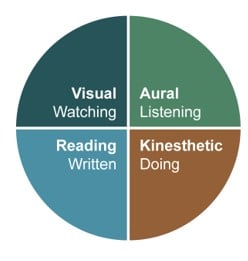Guest post from Product Focus
We speak to many clients evaluating the training options for improving their product management. These range from individuals looking to upskill or reskill, to global teams looking to raise the bar on performance and standardize best practice.
As European Leaders in product management training, our experience and learnings over the last sixteen years have been extensive.
Product management training: questions we get asked
- What’s the difference between live online learning and face-to-face training?
- How do you keep people engaged in online training?
- Is eLearning better than instructor-led?
- How does a private course differ from a public course?
- What’s the best option for training individuals and product teams?
- Which product management training course is right for me?
We answer these questions below.

With so many options available, it can be challenging to know what’s best for you, your team, and your organization. There’s much to consider when deciding on the best learning and development training course, and when talented product managers are in short supply, these programs are more important than ever.
And then there’s the question of whether to train or not – the classic corporate dilemma of whether to invest in employees…
Today’s training landscape
It shouldn’t come as a surprise that training is critical in both employee onboarding and retention, and product people who are effectively trained are likely to be happier and more productive. Your organization’s best assets are its people.
A survey of 2,500 companies found that those with comprehensive training programs have 218% higher revenue per employee and 24% higher product margins than companies with no formal training program. These results reinforce how it pays to invest in your employee’s development.
Today, there’s a huge variety of ways to train and learn – with face-to-face training, live online instructor-led training, eLearning, a blended approach, and many more options. But which option provides the most benefits? With the global rise in demand for Product Managers in technology, some employers see the value in location flexibility to get the people they need. And when it comes to training these individuals, there are ways to combat different time zones and locations.
Advances in technology have given employers and their staff more training methods than ever. There’s plenty to consider from the budget, location, the opportunity for team-building, the number of learners, objectives and expected outcomes, etc.
Training types
Let’s take a look at some of the most common types of training available to product managers and product management teams today:
- Face-to-face training – typically delivered in a meeting room with delegates, taught in person by an instructor. This allows for live interaction between a learner and an instructor. It’s a tried and tested approach and great at helping with team-building and social interactions.
- Live online instructor-led training – led by an instructor with delegates sitting at their computer at a convenient location. Everyone is connected in a virtual training environment. Training content and online exercises, as well as video, voice, chat, and polls, help to keep everyone engaged.
- eLearning – or electronic learning, is recorded training delivered through a computer and can be accessed at a convenient time and place. There is no live instructor, but the learner can evaluate their progress through regular tests.
So, which is the best training option for you, your team, and your organization? Let’s look at some of the pros and cons of the popular methods.
Training method pros and cons
Face-to-face training:
For many people, the opportunity to interact directly with an instructor and peers is the best environment for them to learn complex topics. Face-to-face continues to be a very popular training approach. The instructor can quickly and effectively answer questions, and broader group discussions can take place around key topics. The downside to face-to-face learning is that everyone has to get to the same venue at the same time. If you’re considering this option, other pros and cons include:
| Face-to-face training | |
|---|---|
| PROS | CONS |
| Lots of social interaction during training sessions with communication between the instructor and learners. This gives the opportunity to share anecdotes, get immediate answers to questions, and ease doubts. This interaction helps to keep people engaged and enables the instructor to provide the highest quality learning experience. | Employees are out of the office, usually for multiple days. Carbon footprint is increased. |
| Fewer chances for distractions – people are expected to focus on the training when in the room and not take calls, answer emails or engage in lengthy tangential discussions that take away from the topics discussed. | If a delegate can’t keep up with the rest of the class, this learning style can put them at a slight disadvantage compared to eLearning. |
| The instructor can see people’s body language and level of engagement, so they can react to problems, call breaks if people are tired, assess exercise results in real-time, or ask questions to validate understanding. | The overall cost of face-to-face training can be higher than its online offering, especially if people have to travel to the training venue. |
| Attendees can learn from one another, and learning can be adjusted as changes occur in real-time. | Face-to-face training can be seen as a one-shot training intervention unless there is a follow-up to ensure people put into practice what they have learned. |
Live online instructor-led training:
Instructor-led training can be highly effective, especially when it comes to more complex or comprehensive topics, as the instructors can answer specific questions or provide resources in a live setting. More and more organizations are seeing the benefits of this type of training for product management professionals as costs are typically lower than face-to-face training, and technology has improved to the point where delegates enjoy an effective training experience.
| Live online instructor-led training | |
|---|---|
| PROS | CONS |
| Creates the ability to train people in a place convenient to each delegate. So, no travelling costs and avoids mixing in person e.g. if there are Covid concerns. Overall supports a reduced carbon footprint. | No face-to-face human interaction which is an important part of the training experience for many delegates. |
| While not as sociable as face-to-face training, there is good communication between the instructor and learners with live online training. This gives the opportunity to share anecdotes, get immediate answers to questions, and ease doubts. This interaction helps keep people engaged and delivers a quality learning experience. However, classes should be similar to face-to-face in size to interact with delegates effectively and efficiently. | Technical issues can arise with everything taking place in a virtual environment. |
| Live online training offers many options for flexible delivery, including breakout groups, chat, polls, discussions, and online exercises. A unique facility is the ability to immediately share digital content produced during exercises, allowing feedback from the instructor and peers and having a copy to deliver further post-training. | With online learning versus face-to-face training, there is increased screen time, which creates the opportunity for distraction from email, chat, and other work (though the instructor will try and pick up on this). |
| Cost is typically cheaper than face-to-face training. | The training provider needs to be mindful of cultural differences, and without having delegates in the room, engagement could be challenging. |
eLearning:
Recorded computer-based training has become a popular method for training teams on a large scale, especially for mandated regulatory and compliance training such as safety at work courses. Employees can undertake the training at a time and location to suit them and on any device as long as it has an internet connection. eLearning often comprises elements such as gamification, activities, videos, and surveys – but keeping this training style new and fresh (as is best practice) can be challenging at times. Because learners aren’t monitored, it isn’t easy to know if they engage with the material or share answers with colleagues.
| eLearning | |
|---|---|
| PROS | CONS |
| Certain expenses such as training facility costs, travel costs, employee time away from the office, etc., are greatly reduced. Supports a reduced carbon footprint as no travelling to a venue is required. | Upkeep costs involved in online training, such as a Learning Management System subscription, course materials, keeping courses and systems updated, administration, etc. |
| Very convenient as delegates can take the training at a time that suits them. | Requires employee discipline to learn. Reduces the personal and team-building elements. eLearning also typically doesn’t include practical sessions where learners can practice their skills. |
| Educate on new training and concepts within a business quickly, with short, quick eLearning modules. Great for compliance training, delivered at scale. | With self-paced learning, there is always the possibility of procrastinating, but with live face-to-face or online lessons, you are encouraged to participate. |
The four ways of learning and a blended approach

Studies show that learners can develop a deeper understanding of content when received more than one way. There are four major learning styles, and the best training methods and courses for product people target all of these.
With that in mind, many organizations are looking to undertake a more blended approach to their training. They seek product management training programs that incorporate many elements, including face-to-face and online elements, basic and advanced content, self-learning, interactions, certifications, and more.
Public vs. private training
Alongside the choices of what style of training you should be undertaking as a product person (or product leader looking to upskill your team), there’s also the question of what’s better: a public or private course? Product Focus delivers multiple public and private courses every month, and we find that:
- Private courses are just for a single company but often include a number of different teams – not just product management but also product marketing, product owners, and others that can benefit from the training and shared experience.
- The advantage of a private course is that it can be customized to the challenges you face and your way of working. Exercises can be changed based on the products in your portfolio, and discussing real-life scenarios can help cement learning. It’s a great way to get everyone on the same page. It also keeps things confidential.
- With public courses, attendees get to interact and hear anecdotes from peers from other technology industries – they’re often pleased to hear that they’re not alone with their challenges!
Summary
Product management training can make a big difference to people’s mindset and performance in their job roles.
Making the right choice of training style and training provider is important because it’s unlikely that, if you buy training that isn’t quite right, you’ll be able to secure the budget to have another go with someone else.
It’s unlikely that eLearning will ever fully replace instructor-led face-to-face or live online learning. Many companies are looking to implement a more blended learning style, and an effective learning program will incorporate a multitude of elements, including basic and advanced content, self-learning, interactions, certifications, and more.
In our experience, it’s not that face-to-face is better than online for product people. We like to use the example of food! Sometimes you want to go out to a restaurant, and other times you want a takeaway – it’s not that one is better than the other; both have their place. But it’s about what is relevant and appropriate for your needs at the time.
eLearning is great for very basic, quick-fire learning – whereas instructor-led face-to-face and live online training provide a more in-depth, comprehensive training experience. Some key questions you should consider when looking for training are:
- What is the overall purpose of the training?
- Who needs to be trained?
- Where are they based?
- What are the activities they need to be able to do?
- What is their current level of experience and performance?
- Do you need group training or individual learning?
- What facilities do you have in-house, e.g., the training facilities for face-to-face training or the quality of internet connections for live-online training?
A report from LinkedIn reveals that 59% of L&D professionals identified upskilling and reskilling as the top priority for training programs in 2021 and beyond. 79% expect organizations to spend even more on training this year. Ensuring you have the right balance in understanding your teams’ training preferences and learning styles, the learning objectives set, overall cost, and the perceived performance benefits for staff once employee training is complete is vital.
How can Product Focus help with your training needs?
Product Leader, Product Manager, Product Owner, Product Marketer… we’re here to support you with our industry-leading public and private training courses. Whether you sell to businesses or consumers, work with software, physical products, or services – if you work with products, we have the course for you.
As European leaders with over sixteen years of experience, we’ve trained thousands of product people who’ve attended our world-class product management courses. Please find out more on how we can support your training needs here.
View a guide to other product management training courses.




